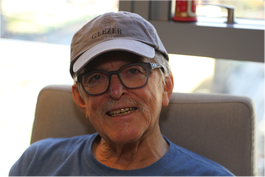 John Worley Symons, 6/7/39 – 9/5/15
John Worley Symons, 6/7/39 – 9/5/15 Of the thousand-plus email address I've scrolled through as I've managed PDX Death Cafe and Death:OK event registration, a few provoke a smile whenever I see them - such as "geezr.symons". When I met the man who claimed the "geezer" honorific at a Death Cafe, I was immediately drawn to his warmth.
Geezer John also turned up at a Death:OK volunteer gathering. He couldn't take on much, he told us, because he was in treatment for a rare form of leukemia. But hearing that we planned to feature a display of origami cranes created as a suicide prevention project in Alaska, he said he could fold cranes.
Little did I know that he was already an expert crane folder. When John and his wife Ann were living in Russia he folded 10,000 cranes in protest of George W. Bush's war with Iraq. Together they had made a pilgrimage to Hiroshima, where the origami crane tradition began with A-bomb victim Sadako Sasaki. The millions of cranes that continue to flock to that site have created a conundrum for local officials.
Earlier this month I discovered a few messages from John logged as unpublished comments on the Death:OK blog. I opened up my email program to compose a response to him when I noticed an email from someone with the same last name. It was John's wife of 48 years with sad news. "Well - hard to say," Ann wrote, "but my husband was quite looking forward to Death:OK… and then he died this past week quite unexpectedly and peacefully from leukemia."
She went on to say, "I know you have a 'crane lady' but I also have some cranes from John that he was making for the event." Ann and I arranged to meet. The bag she brought me contained hundreds and hundreds of cranes, nearly enough for each of the 500 participants at our upcoming event.
I had the privilege, in visiting with Ann, of learning a bit more about John, about the war protest cranes and their pilgrimage to Japan. I admired the simple but stunning hammered silver jewelry she wore, rich in symbolism, made by John - he never sold his work, she told me, only gifted it. We talked about her work as a librarian, about the kindness of John's oncologist (who called her to check in while we were having a cup of tea), and she gave me two of John's books on mortality.
When I told a few of my Death:OK colleagues about John's death and the posthumous gift of his cranes, one remembered that John had been the very first person to purchase a Death:OK ticket. Through his cranes, he'll be there with us.
Ann told me, "Last Friday John wasn’t 'dying' and Saturday morning he was gone. We had spent almost all day at the infusion center - he was total John that day. Thursday we had gone to the Japanese Gardens. Saturday we were planning an outing to Art in the Pearl. The human body works in very mysterious ways and while we always think we have control, we don’t. He lives on in our hearts and memories."
In a final flourish of serendipity, I had an exchange with Ann today, sharing this blog post with her. She shared with me that the day had brought her another blog post from a longtime friend who also cited John's signature cranes. In it, the friend recounts a time the two couples chaperoned a student trip to Egypt. The kids were disinterested in the WWII cemetery in the North African desert until John intervened. His friend recalls:
"As each student stepped off the bus onto sand, John handed her/him an overflowing handful of paper cranes. 'Place these on graves, and as you do, read the names and ages of the soldiers,' he said. The students walked slowly, quietly among rounded headstones, reading. Within minutes, the tan landscape was dotted with color."
With the Jewish high holy days this month, I've thought often of the phrase, May his memory be a blessing. Yours is, John, yours is.





 RSS Feed
RSS Feed